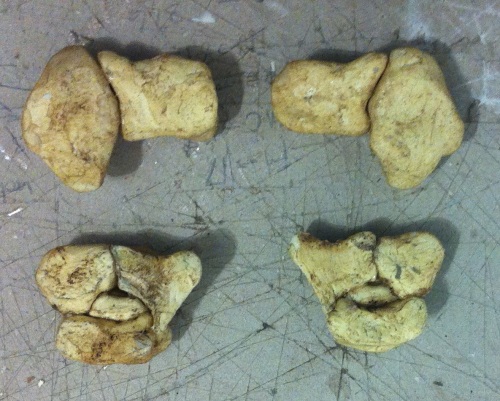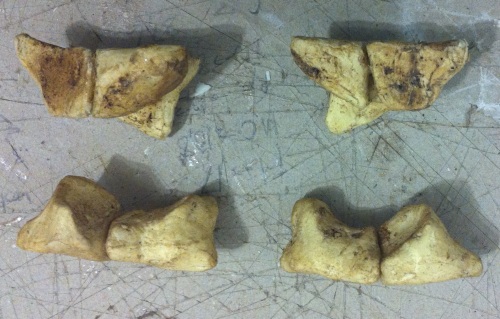The carpals are seven little bones which connect the metacarpals, pteroid and radio-ulna pair together. I had no sources for Tupuxuara, and after spending a day trying to make a pair of syncarpals (fused carpals) from Tapejara, I decided to use Anhanguera as a source. So my Tupuxuara’s wrist actually belongs to Anhanguera.
There are five distal carpals, and four of them are fused together so they actually act as two: the distal syncarpal, which articulates the hand metacarpals, and the pre-axial carpal which articulates the pteroid. There are two proximal carpals, also fused, which connect to the radio-ulna pair. I used Anhanguera (Kellner and Tomida 2000) which provides four views of the proximal and distal syncarpals. I made up the medial carpal (roughly based on other pterosaurs and drawings). I adapted the pteroid from Pteranodon and adjusted its size by a low resolution Thalassodromid fossil photograph (it was not good enough to use the photo as an image source, but I could calculate its proportions relative to the radio-ulna.
This was a first test carving just the two syncarpals, but I didn’t use it. I decided to make individual carpals.
I printed the four views of each syncarpal and coloured each carpal differently to make it easier to identify them on each view.
Then I carved the individual carpals from 3 cm XPS foam. These are the carpals that form the left and right distal syncarpals.
This is the distal syncarpal assembled (showing the side that articulates with the proximal syncarpal).
These are the parts that make the left and right proximal syncarpals.
And these are the proximal syncarpals assembled.
Since they are usually fused (in mature pterosaurs), I glued them together with silicone glue (which retains some flexibility). Here is a view of all the syncarpals (showing the sides that connect to each other).
Now the other side. This is the side that connects to the bones (proximal syncarpal to radio-ulna, and distal syncarpal to the wing metacarpals.
Anterior view.
Posterior view.
This is the distal end of the radio-ulna pair with the carpals connected. The bone that is pinned at the right is the pre-axial carpal. It articulates with the pteroid (via a sesamoid bone) and with the distal syncarpal. The Anhanguera specimen I used as a source didn’t have one so I “invented” one based on some photos of Pteranodon fossils (I used the article “Articulation and Function of the Pteroid Bone of Pterosaurs”, by S. C. Bennett, 2007 as a source).
Here are some side views.
Now the pteroid. It has a very thin and fragile tip. To make it stronger I stretched a piece of PVC plastic (from a plastic hanger) to serve as a bone skeleton.
I used two halves of 5 mm XPS foam, and a plastic bone skeleton.
Opened a cavity on both sides and sandwiched the plastic skeleton inside.
After carving, staining, etc. we have a pair of pterosaur pteroid. Here is the full collection partially connected. The pteroid connects to the sesamoid bone, which connects to the pre-axial carpal, which connects to the distal syncarpal, which connects to the wing metacarpal.
And now our Tupuxuara has a wrist and pteroid.
We still need fingers (including metacarpals), feet (including ankle bones), tail and pre-pubis. I’m not sure I will have time to include the pre-pubis this week. I might leave it for later when I plan to make some minor fixes and possibly introduce new ribs, gastralia and cartilage (in silicone rubber).


















